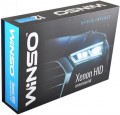The type determines the operating principle of the auto lamp and its design features.
— Incandescent. In this case, we mean traditional
incandescent lamps, not related to “halogens” (see below). The bulb of such a lamp is filled with an inert gas or vacuum, and the light is provided by a red-hot filament of refractory metal. The main advantage of such light sources is their simplicity and low cost. At the same time, both in terms of efficiency and performance parameters such as brightness and service life, they are inferior to more advanced varieties, therefore, in general, they are considered obsolete and are used extremely rarely for headlights - the main area of application for incandescent lamps is auxiliary lighting and the instrument panel (see. "Destination")
—
Halogen. A specific type of incandescent lamp (see above), differing in the composition of the gas in the bulb - it contains halogen vapor, usually bromine or iodine. This allows for greater brightness, increased efficiency and lifespan, while reducing size and power consumption - all without significantly increasing cost. True, in terms of efficiency, such lamps are still inferior to LED models; on the other hand, halogens provide a more natural glow and are better suited for working over long distances. Thanks to this combination of characteristics, this particular type of lamp is the most popular as a head light (see “
...Purpose”); and although xenon lamps are more diverse in the number of models, halogen lamps surpass them in the overall frequency of use.
— Light-emitting diode (LED). LED lamps are notable primarily for their extremely high efficiency, which allows them to achieve high brightness with low power consumption. True, such models are highly expensive, and the color of their glow is “colder” and less natural than that of incandescent lamps. LED lamps are more expensive than halogen lamps, but they are superior in energy efficiency, which helps save fuel. Therefore, in the role of head light (see “Purpose”), this type of lamp is becoming more and more common, gradually replacing halogen lamps. And in auxiliary lighting, “LEDs” are perhaps the most popular variety. We also note that among such lamps there are models that can work with both operating voltages - 12 V and 24 V; See "Voltage" for details.
— Xenon. Classic xenon lamps that have one operating mode (unlike bi-xenon, see below) and are designed for cars where two separate lamps are used for low and high beam. In all xenon auto lamps, the bulb is filled with the inert gas xenon containing pairs of specially selected metals, and the light source is an electric discharge in the environment of this gas. Such models are quite expensive and complex in themselves; in addition, to operate they require a special ignition unit (see below), and it is not always supplied. On the other hand, due to its high brightness and efficiency, xenon is considered the most advanced type of headlight lamps (see “Purpose”); such lamps, among other things, are popular among fans of external tuning. This variety is not used in principle for auxiliary lighting.
— Bi-xenon. Xenon lamps (see above), which have two operating modes and are capable of providing both low and high beam. The exact method for switching between modes may vary. Thus, some models use a movable reflector that changes the characteristics of the light beam; in others, two xenon capsules are installed in one flask; in others, two separate bulbs are used, etc. You should pay attention to this option if both the low and high beam in the headlight are provided by one lamp. Such models are not cheap - more expensive than the xenon/halogen alternative (see below) - but they are used much more often due to their more advanced characteristics.
— Xenon/halogen. Combined lamps having two separate bulbs: xenon for low beam and halogen for high beam. For more information about each of these types, see above; and this option is an alternative to bi-xenon (also see above) for cars where one lamp is responsible for the low and high beam. Xenon-halogen lamps are noticeably cheaper than bi-xenon lamps, and are inferior in efficiency mainly when using high beams. On the other hand, the xenon part usually has a shorter service life than the halogen part, and if it fails, the entire lamp will have to be replaced. In addition, the bulbs may not be located on the same axis, which in some cases causes problems with adjusting the headlights; and the heat generation during operation of both bulbs is quite high and in some cases can even lead to damage to the headlight. As a result, there are significantly fewer combination lamps on the market than bi-xenon lamps.Availability of an ignition unit (ballast) included in the lamp delivery set. Such a unit is used with xenon lamps (see “Type”) and is intended to increase the voltage: to operate such a lamp, you need a higher voltage than the standard 12 V or even 24 V, and at the moment of ignition you need to apply a pulse of several kilovolts to it. Ballast provides both.
A set of lamps and an ignition unit is called
a “xenon kit”. This option is especially convenient in cases where xenon is installed for the first time, instead of another type of lamp, or when replacing the entire old set. Among other things, the “native” ignition unit, by definition, is optimally suited for complete lamps, while a third-party one must also be selected according to the type of base and other characteristics.

